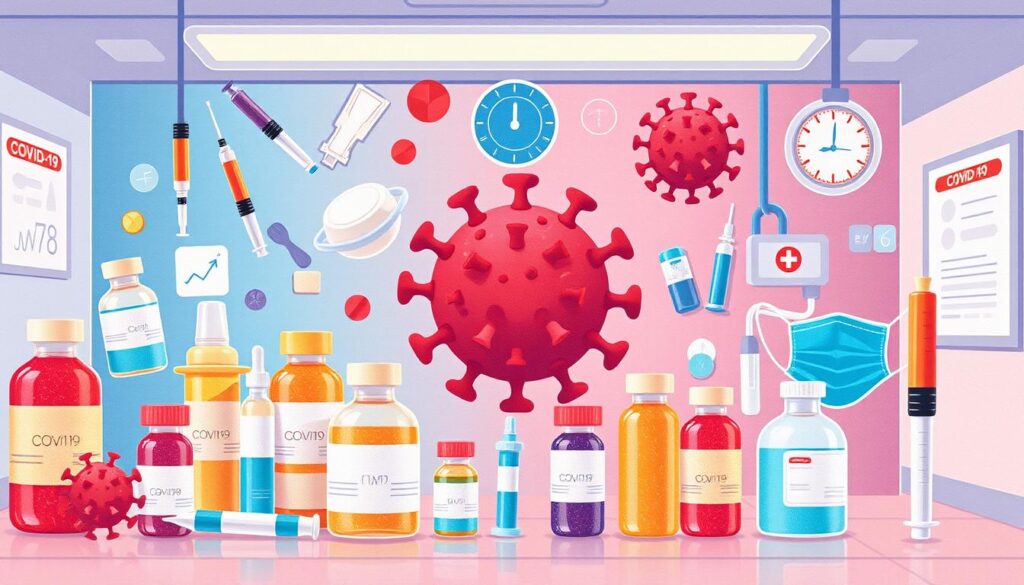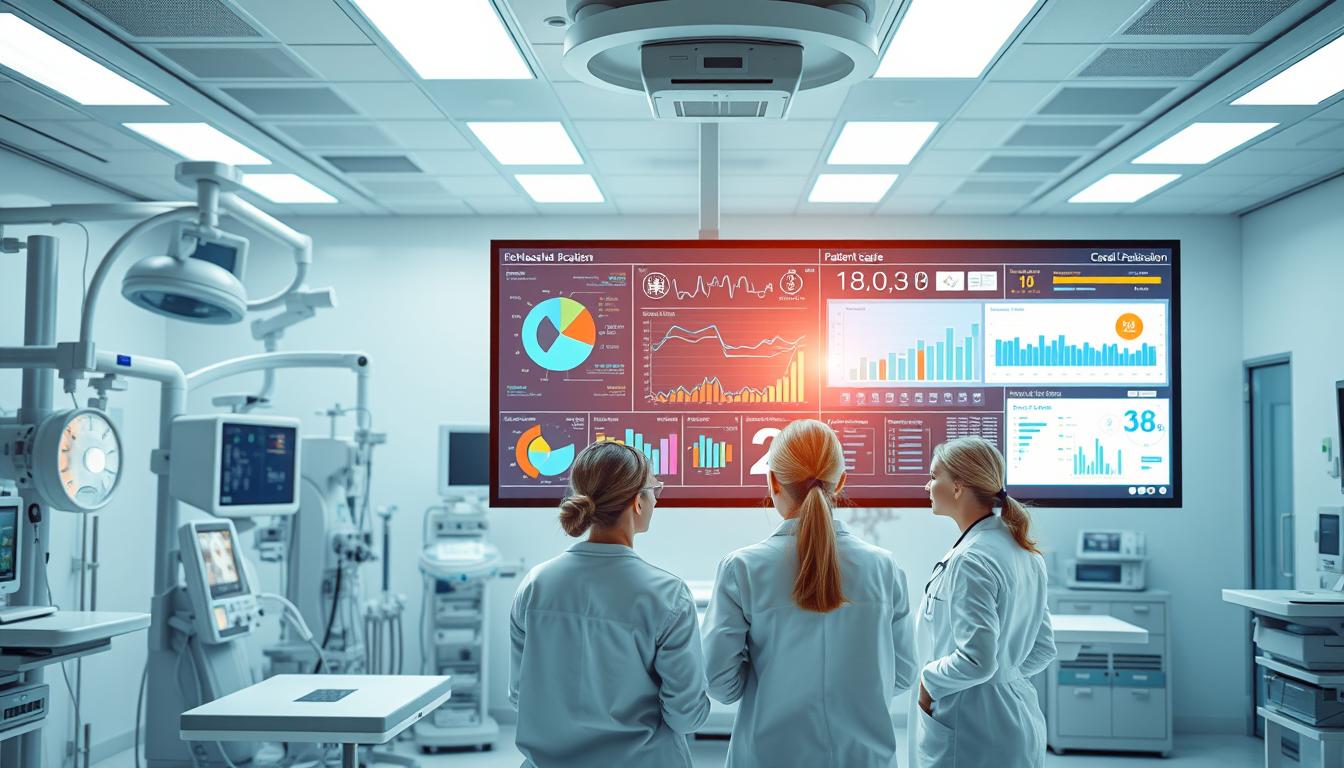The coronavirus pandemic keeps changing, and it’s key to know the latest health care news and treatments. This guide covers the current COVID-19 response. It includes info on vaccines, testing, and treatments for those at high risk.
Recent data from the Infectious Diseases Society of America (IDSA) shows that COVID-19 treatments work best within 5 to 7 days of symptoms. By February 2, 2023, many SARS-CoV-2 variants in the U.S. are not affected by most antibodies. This highlights the need to keep up with vaccine advice and follow health guidelines.
The Centers for Disease Control and Prevention (CDC) says people 6 months and older in New York can get the updated COVID-19 vaccine. Free tests are also available from the federal government. If you’re feeling sick or have been exposed, test right away. If you test positive and are at high risk, get treatment to avoid serious illness.
Key Takeaways
- Stay informed about the latest health care virus updates and treatment options
- COVID-19 treatments are most effective when given within 5 to 7 days of symptom onset
- Updated COVID-19 vaccines are available for individuals 6 months and older in New York
- Free tests are available from the federal government
- Seek treatment options if you test positive and are at high risk for severe illness
Understanding the Virus: What You Need to Know
As the world fights the pandemic, knowing about the COVID-19 virus is key. Thanks to medical research advancements and epidemiological data analysis, we’ve learned a lot. This knowledge helps us understand the disease better.
Overview of the Virus
COVID-19 is caused by the SARS-CoV-2 virus, which started in December 2019. It likely came from animals before infecting humans. By July 29, 2022, it had killed millions, showing how critical it is to know about it.
Symptoms and Transmission
The common symptoms of COVID-19 are:
- Fever or chills
- Cough
- Shortness of breath
- Fatigue
- Muscle or body aches
- Headache
- New loss of taste or smell
- Sore throat
- Congestion or runny nose
- Nausea or vomiting
- Diarrhea
The virus mainly spreads through respiratory droplets when someone coughs, sneezes, or talks. It can also spread by touching contaminated surfaces and then touching your face. People can spread the virus for up to two days before showing symptoms and stay contagious for 10 to 20 days.
Who is Most at Risk
While anyone can get COVID-19, some groups face a higher risk. These include:
- Older adults
- People with health issues (like heart disease, diabetes, lung disease)
- Those with weakened immune systems
- Pregnant women
More than 98% of the U.S. population has some protective immunity against COVID-19.
It’s important for everyone to take steps to stop the virus from spreading.
By keeping up with the latest information and medical research advancements, we can protect ourselves and others. Epidemiological data analysis helps track the virus, guiding health measures and treatments.
Current Health Care Guidelines
The world is still facing challenges from the pandemic. It’s important to know the latest health guidelines. The Centers for Disease Control and Prevention (CDC) and local health authorities update their advice often. They do this to keep communities safe in the United States.
CDC Recommendations
The CDC stresses the need for key steps to fight the virus. These steps include:
- Wearing well-fitted masks in public, especially where the virus spreads a lot
- Keeping at least six feet away from others outside your home
- Washing your hands often with soap and water for 20 seconds or using hand sanitizer with at least 60% alcohol
The CDC also says everyone 6 months and older should get the updated COVID-19 vaccine for the 2024-2025 season. Getting vaccinated helps protect you and others from getting very sick or needing to go to the hospital.
Local Health Authority Updates
It’s also key to follow local health advice, in addition to CDC guidelines. Local updates might include:
- Current case numbers and how fast the virus is spreading in your area
- Where to find testing sites and if they have openings
- Info on getting vaccinated and who can get it
- Rules on wearing masks and keeping distance in public places
Local health groups are also crucial in tracing who might have been exposed to the virus. This helps stop the virus from spreading and keeps those at risk safe.
Always wear a mask for 5 days after leaving home when feeling better from COVID-19.
Following health guidelines and helping with contact tracing is something we all must do. By working together and listening to experts, we can manage the pandemic. This way, we can keep our communities healthy and safe.
Treatment Options Available Today
Medical experts and researchers are racing to find effective treatments for COVID-19. Vaccines are key in preventing severe illness and death. But, antiviral medications and supportive care are also helping those who get the virus.

Antiviral Medications
The FDA has approved several antiviral drugs for mild to moderate COVID-19. These include Paxlovid, Veklury (remdesivir), and Molnupiravir (Lagevrio). Given early, these drugs can lower the risk of serious illness and death in high-risk patients.
It’s vital to remember that these medications are not a replacement for COVID-19 vaccines. Patient assistance programs may offer these drugs at a lower cost. But, they should not replace getting vaccinated.
Research is ongoing to find more treatments for COVID-19. The RECOVER Initiative by the National Institutes of Health (NIH) is looking into treatments for Long COVID symptoms.
Supportive Care Techniques
Supportive care is also important in managing COVID-19 symptoms. This includes oxygen therapy, fluids, and medications for specific symptoms. Older adults and those with chronic conditions are at higher risk and may need more care.
It’s important for patients to talk to their healthcare providers about the best treatment. By working with medical experts and staying updated on treatment options, individuals can get the care they need to recover.
The Role of Vaccines in Treatment
Vaccines are key in fighting infectious diseases, like COVID-19. They help reduce the virus’s spread and severity. This brings hope for a return to normal life.
In the U.S., two COVID-19 vaccines are available. mRNA vaccines, from Pfizer-BioNTech and Moderna, teach cells to make a protein that triggers an immune response. These vaccines have shown high success in preventing illness and severe disease.
Protein subunit vaccines, like Novavax’s, use virus parts to stimulate immune responses. This technology has been used for over 30 years. It’s used in vaccines for diseases like hepatitis B and whooping cough.
Overview of Available Vaccines
The COVID-19 vaccines in the U.S. have been tested on thousands of volunteers. These trials have shown the vaccines are safe and effective. They prevent severe illness, hospitalization, and death.
The FDA granted Emergency Use Authorizations (EUAs) for these vaccines. Later, they gave full approvals after detailed reviews.
Efficacy and Safety Information
Millions of people in the U.S. have gotten COVID-19 vaccines. Common side effects include pain at the injection site and fever. Serious side effects are rare.
Vaccine updates are needed to fight new variants. The 2024–25 vaccines protect against current variants with just one shot. Children and those with weakened immune systems might need more shots.
Natural immunity to the virus fades faster than vaccine immunity. This highlights the need for regular COVID-19 vaccinations. The FDA-approved vaccines have met strict safety and effectiveness standards.
Telehealth Services: A Modern Approach
Telehealth services have changed the healthcare world. They let patients get medical care without having to go to the doctor’s office. During the COVID-19 pandemic, more people started using telemedicine. In just a 4-week period, the share of telehealth visits surged from less than 1% to an astounding 70% of total visits at some institutions.
Telehealth has many benefits. It lets patients get care without leaving their homes. This reduces the risk of getting sick and saves time. It also helps people in rural areas or with mobility issues get the care they need.
Another plus is that patients can keep up with their care plans. They can have regular check-ups and monitoring online. This keeps their care going smoothly.
Benefits of Telehealth
Telehealth services have become more popular for good reasons. Here are some of the main benefits:
- Convenience: Patients can get medical care from home, saving time and effort.
- Reduced exposure risk: Virtual visits lower the risk of getting sick, like with COVID-19.
- Increased accessibility: Telehealth makes healthcare easier to get for people in remote areas.
- Continuity of care: Regular check-ups and monitoring can happen online, keeping care consistent.
When to Use Telehealth for Virus Concerns
Telehealth is especially useful for virus concerns. It’s good for:
- Symptom assessment: Patients can talk about their symptoms with a doctor online, getting advice on what to do next.
- Monitoring: Doctors can check vital signs like temperature and oxygen levels remotely through telemedicine.
- Follow-up visits: People who have tested positive for a virus can have online check-ups to see how they’re doing and adjust their treatment if needed.
“Telemedicine encounters increased 766% in the first 3 months of the COVID-19 pandemic, from 0.3% to 23.6% of all interactions from March to June 2019.”
As healthcare keeps changing, telehealth will become even more important. It helps manage viruses and improve patient care. By using telemedicine, healthcare providers can make care better, more accessible, and focused on the patient’s needs.
Mental Health Considerations During Outbreaks
The COVID-19 pandemic has really affected mental health. Many people feel more stressed and anxious. Healthcare workers have been under a lot of pressure.
In China, about 4% of medical staff got infected. A study found that 12.5% of hospital staff felt anxious during the pandemic.

To deal with stress and anxiety, keep routines, stay in touch with others, and take care of yourself. Sharing positive stories of people who beat COVID-19 can lift spirits. It’s also key to support healthcare workers’ social connections and fight off feelings of isolation and stigma.
Stress and Anxiety Management
A study showed that 44.6% of people felt anxious because of COVID-19. This shows how the pandemic affects our mental health. To handle stress and anxiety, try these:
- Maintain a regular routine
- Practice relaxation techniques like deep breathing or meditation
- Do physical exercise and go outside
- Stay in touch with friends and family
- Limit news and social media about the pandemic
Resources for Mental Health Support
There are many resources for mental health during the pandemic. These include:
- The National Center for PTSD and American Psychological Association offer support and interventions for mental health needs
- The Disaster Distress Hotline (1-800-985-5990) provides 24-hour mental health support
- The National Suicide Prevention Lifeline (1-800-273-8255) is available for individuals in psychological crisis
- The Substance Abuse and Mental Health Services Administration (SAMHSA) offers a helpline (1-800-662-4357) for information on mental health and substance use disorders
It’s important to take care of your mental health, especially during tough times. Follow public health guidelines, take care of yourself, and use available resources. This way, you can handle the emotional challenges of the pandemic better.
Importance of Regular Testing
Regular COVID-19 testing is key to stopping the virus’s spread. It helps find infected people early, even if they don’t show symptoms. This way, we can keep our communities safe and treat those who test positive quickly.
Types of Tests Available
There are two main COVID-19 tests: molecular and antigen. Molecular tests find the virus’s genetic material and are very accurate. But, they take days to get results.
Antigen tests, on the other hand, find virus proteins and give results in 15-20 minutes. They’re quick but might miss some cases.
Antibody tests also exist. They check if your body has fought the virus. These tests help us understand the virus better, even if they can’t diagnose current infections.
How Testing Helps Control Spread
Testing is a big part of fighting COVID-19. It helps us:
- Keep infected people away from others
- Find and isolate people who were exposed
- See if our health rules are working
- Use healthcare resources wisely
As we learn more about COVID-19, testing keeps being a key part. By getting tested regularly, we help keep everyone safe. This is how we fight the pandemic together.
Public Health Initiatives for Community Safety
Public health initiatives are key in keeping communities safe during health crises. They educate and empower people to fight infectious diseases. By tracing contacts and analyzing data, officials can pinpoint and tackle high-risk areas.
Awareness Campaigns
Awareness campaigns are essential in public health efforts. They teach people about handwashing, social distancing, and mask-wearing. Through social media, TV, and radio, officials spread the word far and wide, fighting false information.
“CDC recommends staying up to date with vaccinations for flu, COVID-19, and RSV to protect against serious illness, hospitalization, and death.”
The CDC stresses the importance of vaccinations against flu, COVID-19, and RSV. These shots help prevent severe illness and death. Awareness campaigns push for vaccination, highlighting its role in keeping everyone safe.
Community Resources
Public health also focuses on making care accessible to all. Free testing and vaccine clinics are set up in various places. This ensures everyone can get the help they need, no matter where they live.
But it’s not just about physical health. Mental health support is crucial too. Organizations like SAMHSA help people deal with pandemic-related stress and anxiety. By covering both physical and mental health, public health initiatives aim for total community safety.
Personal Hygiene Practices to Follow
Personal hygiene is key in fighting infectious diseases today. By sticking to public health guidelines, we help keep our community safe and healthy.
The CDC says washing your hands with soap and water for 20 seconds is crucial. If you can’t find soap, use a hand sanitizer with 60% alcohol. Make sure to rub your hands all over until they’re dry.
Handwashing Guidelines
Here’s how to wash your hands right:
- Wet your hands with clean, running water (warm or cold) and apply soap.
- Lather your hands by rubbing them together with the soap, making sure to cover the backs of your hands, between your fingers, and under your nails.
- Scrub your hands for at least 20 seconds. Need a timer? Hum the “Happy Birthday” song from beginning to end twice.
- Rinse your hands well under clean, running water.
- Dry your hands using a clean towel or air dry them.
Face Mask Usage
Wearing a face mask is also important. Make sure it fits well and covers your nose and mouth. Choose cloth masks with multiple layers for better protection.
“Masks are a simple barrier to help prevent your respiratory droplets from reaching others. Studies show that masks reduce the spray of droplets when worn over the nose and mouth.” – Centers for Disease Control and Prevention (CDC)
By following these hygiene tips and public health guidelines, we can all help stop the spread of diseases. This makes our community safer for everyone.
Future Outlook for Virus Management
The world is still dealing with the COVID-19 pandemic’s effects. But, research and development give us hope for better virus management soon. Scientists are working hard to find effective treatments and vaccines. They aim to keep up with new virus variants.
Vaccine progress has been key in fighting the virus. Over 770 million people worldwide have been infected. More than 6.9 million have died as of August 2023.
Ongoing Research and Development
Researchers are improving treatments, vaccines, and diagnostic tools. This is crucial for managing the virus. They have developed antiviral medications and care techniques that help COVID-19 patients.
Scientists are also studying how virus variants affect vaccine effectiveness. This ensures vaccines work against new strains. Ongoing research is vital to prevent future outbreaks.
Predictions for the Coming Months
Experts say vaccination and booster shots will be key in the coming months. They stress the need to keep up with preventive measures. This includes wearing masks, washing hands, and social distancing.
Telemedicine and mobile health apps will become more important. They help provide care remotely and reduce virus exposure. Healthcare systems are also changing to handle future outbreaks better.
While the future is uncertain, research and vigilance offer hope. By working together and using medical research and vaccines, we can overcome the pandemic. This will help us build a stronger future for everyone.















Leave a Reply